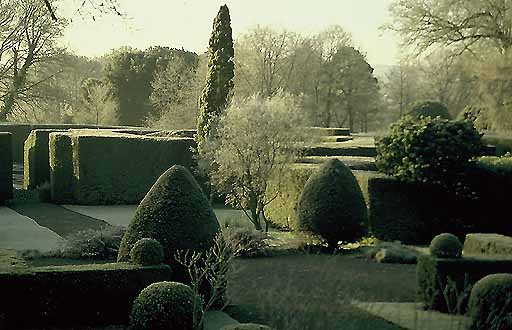A sad story (in French) from Sara concerning the demolition of walled gardens in Montreuil that since the middle ages have been used for the cultivation of peaches to supply markets in Paris. No doubt all in the name of progress.
Wednesday 23 May 2012
Some of the stories behind our Fruits & Vegetables
Just want to share a short video which tells the stories behind a handful of the edibles that feature in Heritage Fruits & Vegetables.
Please do also have a look at the Facebook group (you will have to sign into your own Facebook account) and share with us any stories, recipes, ideas, questions etc. that you have.
Growing your own in early Chicago
Chicago History Museum has posted a fascinating article on its blog entitled ‘Gardening as a civil duty’ which discusses how early settlers had to grow their own edible crops, as they were unable to rely on provisions shipped west by very primitive methods.
 |
| Fort
Dearborn in 1808 - community’s garden in the
foreground. (attrib. iCHI-37865) |
One of the illustrations (shown here) is a 1808 plan of Fort Dearborn, including the designated area of the community’s garden in the foreground. Fort Dearborn was built by Captain John Whistler and his troops in 1803 beside the Chicago river in what is now the city of the same name. The original fort was destroyed following the Battle of Fort Dearborn in 1812, and a new fort was constructed on the same site in 1816 .The fort was de-commissioned by 1837, and parts of the fort were lost to the widening of the Chicago River in 1855 and a fire in 1857; the last vestiges being destroyed in the Great Chicago Fire of 1871. The site of the fort is now a Chicago Landmark, part of the Michigan–Wacker Historic District.
Monday 21 May 2012
Ancient Bablyon under threat
 |
| How it may have looked |
According to RT the remains of the Hanging Gardens of Babylon in what is now Iraq, are under threat.
Certainly the remains of the ancient city are situated near present-day Al Hillah in Babylon Province south of Baghdad and the country has long been trying to get UNESCO World Heritage status for what was once one of the Wonders of the Ancient World.
But now it appears that there has ben a volte-face for the Oil Ministry now plans to lay an oil pipeline right through the archaeological site from north to south.
No doubt that this is a potential catastrophe for the heritage of Iraq, but it may not in fact damage the remains of the Hanging Gardens, for it has never been definitely proven where the garden was in fact constructed.
Certainly the remains of the ancient city are situated near present-day Al Hillah in Babylon Province south of Baghdad and the country has long been trying to get UNESCO World Heritage status for what was once one of the Wonders of the Ancient World.
But now it appears that there has ben a volte-face for the Oil Ministry now plans to lay an oil pipeline right through the archaeological site from north to south.
No doubt that this is a potential catastrophe for the heritage of Iraq, but it may not in fact damage the remains of the Hanging Gardens, for it has never been definitely proven where the garden was in fact constructed.
 |
| The Hanging Garden at Nineveh |
In fact, the general consensus is that the garden was constructed by king Sennacherib (r.701-681 BC) and not Nebuchadnezzar II (r.605-562 BC) and in Nineveh rather than Babylon.
Sadly, just as the remains of Ancient Babylon are under threat, so are those of Nineveh. Saving Our Vanishing Heritage a project under the umbrella of the Global Heritage Fund, an ‘international conservancy that has worked for nearly a decade to protect and preserve the most significant and endangered cultural heritage sites in the developing world’ has Nineveh listed as a site on the verge of ‘irreversible loss and destruction’.
For those wish to know more about the question of Nineveh and the Hanging Gardens, the following article has much more information, but I can't find a link for it: ‘Nineveh, Babylon and the Hanging Gardens: Cuneiform and Classical Sources Reconciled’ by Stephanie Dalley and published in the journal Iraq: vol. 56 (1994), pp. 45-58.
Sadly, just as the remains of Ancient Babylon are under threat, so are those of Nineveh. Saving Our Vanishing Heritage a project under the umbrella of the Global Heritage Fund, an ‘international conservancy that has worked for nearly a decade to protect and preserve the most significant and endangered cultural heritage sites in the developing world’ has Nineveh listed as a site on the verge of ‘irreversible loss and destruction’.
For those wish to know more about the question of Nineveh and the Hanging Gardens, the following article has much more information, but I can't find a link for it: ‘Nineveh, Babylon and the Hanging Gardens: Cuneiform and Classical Sources Reconciled’ by Stephanie Dalley and published in the journal Iraq: vol. 56 (1994), pp. 45-58.
Sunday 20 May 2012
London Historic Garden Walk
Tom Turner, Principal Lecturer in Garden History at the University of Greenwich’s School of Architecture, Design & Construction and the driving force behind gardenvisit.com has has created a 20 mile walking tour of London’s secret gardens to celebrate the inaugural Chelsea Fringe, the off-shoot of the RHS Chelsea Flower Show.
The walk, which can also be followed by bike, stops at 40 points through London, following a loop covering over 3,500 years of history, from Henry VIII’s hunting grounds to Roman gardens and a modern city farm.
Visit London Gardens Walk for the route and for more information. There is also an e-book available for Kindle - and today it will be free to download.
The Chelsea Fringe Festival runs until 10 June.
The walk, which can also be followed by bike, stops at 40 points through London, following a loop covering over 3,500 years of history, from Henry VIII’s hunting grounds to Roman gardens and a modern city farm.
Visit London Gardens Walk for the route and for more information. There is also an e-book available for Kindle - and today it will be free to download.
The Chelsea Fringe Festival runs until 10 June.
Restoriang the Nehrling Gardens in Gotha, Florida
 |
| Henry Nehrling (from Nehrling Gardens) |
Another garden restoration story, but this time form the other side of the Atlantic. According to ClickOrlando the historic garden of Palm Cottage Gardens, which is the former home of famed horticulturist Henry Nehrling, is on a fundraising drive in order to restore the gardens.
 |
| Site Plan (from Nehrling Gardens) |
 |
| The house & garden today (from Nehrling Gardens) |
Restoration of Wepre Park
 |
| The house has sadly been demolished (image from BBC News website) |
The BBC News website is reporting that Flintshire County Council in north Wales has secured funding from the Heritage Lottery Fund to develop a restoration plan to conserve, restore and improve the historic gardens of Wepre Park.
The Council provides a brief history of Wepre Park which notes that: 'At the southern end of Wepre Park are the remains of Ewloe Castle
which was built in 1210 and extended by the Welsh Princes in 1257, it is
a scheduled ancient monument. Wepre hall itself was built in 1770 and
in the 18th century formal grounds and gardens were laid out
and then further extended in 1880. The estate at that time would have
covered over 30 hectares including some of the farms which are next to
the park and much of Connah’s Quay. After the First World War the estate was broken up and sold,
eventually to Connah’s Quay Urban District Council. Following the Second
World War the Hall was used for council housing with the external
building being used for the council’s Park’s and Gardens department. By
1960 the house had fallen into disrepair and was demolished. During the
1970’s and 1980’s the site was developed into a country park. Today you
can still see the remenants of the landscaping from the 1800’s around
the visitors centre.'
 |
| The gardens in the C.18 & C.19 (image from BBC News website) |
The cost of the project, which aims to restore the gardens back to their prime in the 18th and 19th centuries, is estimated to be in the region of £750,000.
Thursday 3 May 2012
Rare chance to visit Ammerdown House gardens in Somerset
The gardens of Ammerdown House were designed by Arts and Crafts architect Sir Edwin Lutyens in 1902 to complement the house by James Wyatt (1788.) Still owned by the Joliffe family, the private gardens will be open to the public on Monday 07 May between 11am and 5pm (and again on Monday 27 August) in aid of charity.
The gardens are 10 miles south of Bath on the B3139 at Kilmersdon in Somerset - directions and more information can be found on this Parks and Gardens UK entry.
Tuesday 1 May 2012
The Gardens of Zuisen-ji Temple
Fading temple bell
The fragrance of flowers strikes
At evening.
(Haiku by Matsuo Basho)
Stephen Mansfield, the author of the recently published Japan's Master Gardens: Lessons in Space and Environment has penned an interesting article entitled 'Kamakura's historic 'flowering garden'', which is published in The Japan Times tells of the gardens of Zuisen-ji Temple in Kamakura.
Subscribe to:
Posts (Atom)




